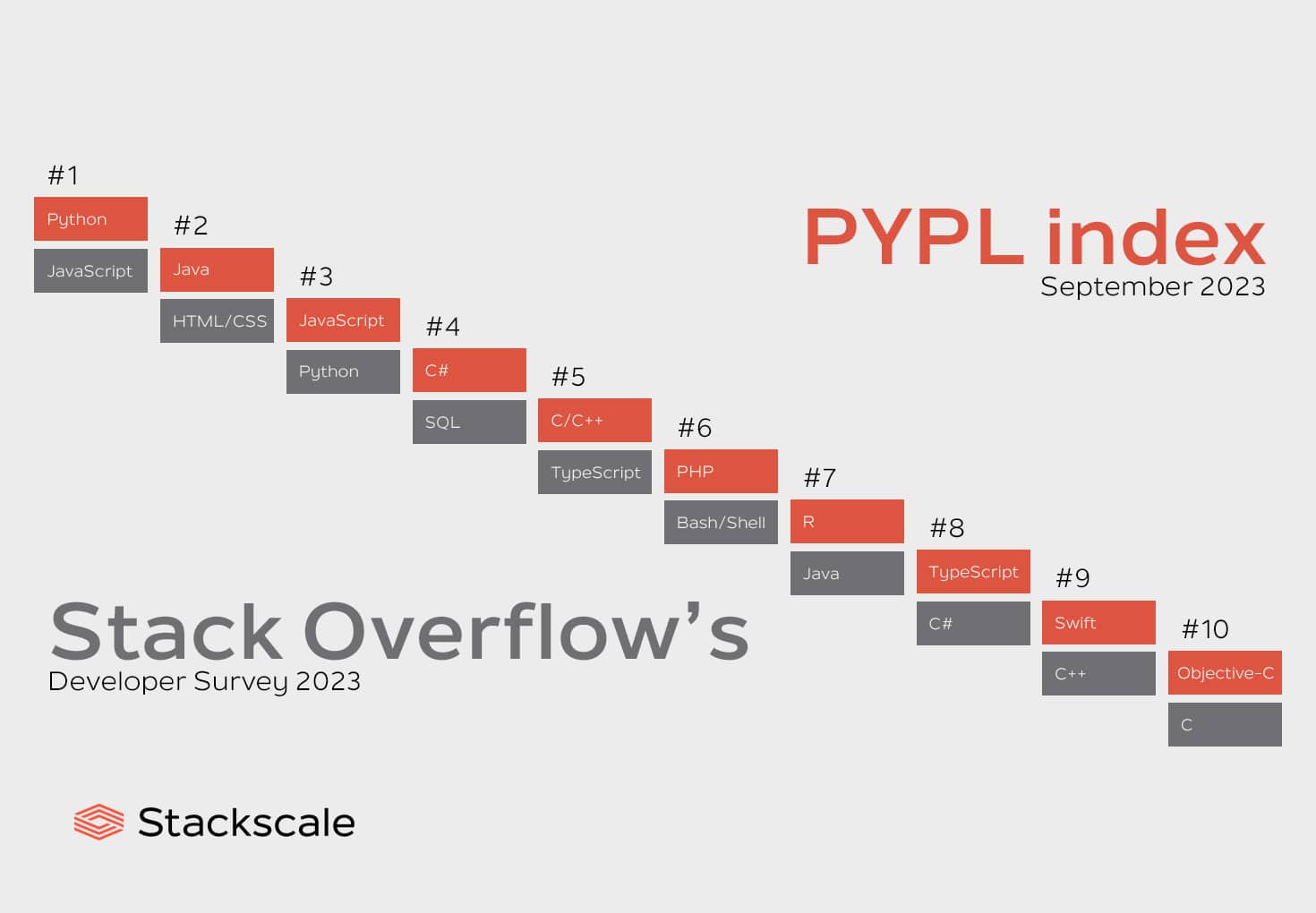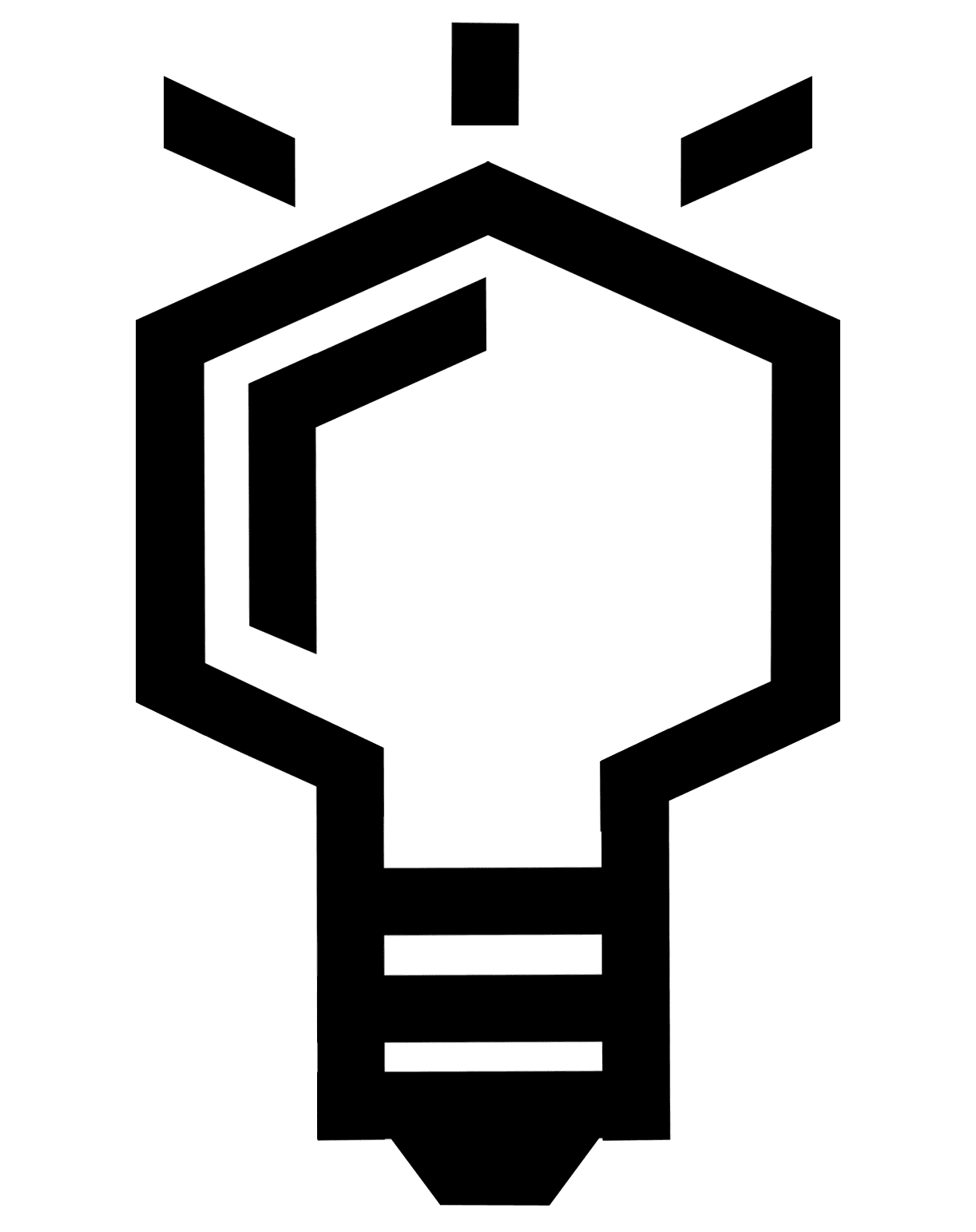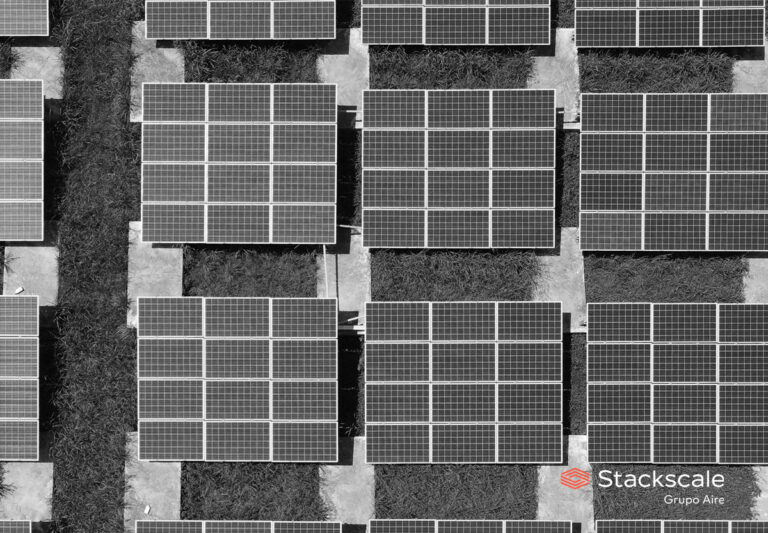Which are the most popular programming languages in 2023? There are different lists of the most commonly used programming languages: the PYPL ranking (monthly updated) and the list of Stack Overflow’s Developer Survey 2023.
Top 10 programming languages in 2023
These are the most popular programming languages according to the PYPL index and Stack Overflow’s Developer Survey 2023.
| Position | PYPL ranking September 2023 | Stack Overflow’s Developer Survey 2023 |
| #1 | Python | JavaScript |
| #2 | Java | HTML/CSS |
| #3 | JavaScript | Python |
| #4 | C# | SQL |
| #5 | C/C++ | TypeScript |
| #6 | PHP | Bash/Shell |
| #7 | R | Java |
| #8 | TypeScript | C# |
| #9 | Swift | C++ |
| #10 | Objective-C | C |
The PYPL index is regularly updated, so this ranking might vary over time.
Programming languages ranking 2023
Let’s take a closer look at the most used programming languages in 2023.
Python
Python is an open source programming language, initially designed by the Dutch programmer Guido van Rossum in the late 1980s. The first version, Python 0.9.0, was released in 1991. It is powerful, user-friendly and easy to learn.
Python is used in many fields such as Machine Learning (ML), automation and scientific computing. It can also serve as a scripting language for web applications. Furthermore, there are diverse Python frameworks, like Django, TurboGears and Flask, that support developers in the development of complex applications.
Current developer: Python Software Foundation.
Last stable release: Python 3.11.5.
Influenced by: ABC, Ada, ALGOL 68, APL, C, C++, CLU, Dylan, Haskell, Icon, Lisp, Modula-3, Perl, Standard ML and VB.
JavaScript (JS)
JavaScript is one of the core technologies of the WWW, together with HTML and CSS. It was initially developed by the American computer programmer Brendan Eich, at Netscape, in 1995. It is a must-have among software developers and a great starting point for beginners.
JavaScript must not be confused with Java, although both of them have a C-like syntax and JS was designed with Java’s syntax and standard library in mind. JavaScript and Java are actually very different:
| JavaScript | Java |
| Dynamic. | Static. |
| Prototype-based. | Class-based. |
| Run on the web browser. | Run on the Java Virtual Machine (JVM). |
Last stable release: ECMAScript 2021.
Influenced by: AWK, HyperTalk, Java, Scheme and Self.
Java
Java was originally designed by the Canadian computer scientist James Gosling, while working at Sun Microsystems, in 1995. It is a particularly popular programming language for server-client web applications. Although it was initially released under proprietary license, it is currently available under GNU GPL 2.0-only license.
Current developer: Oracle.
Last stable release: Java SE 20.
Influenced by: Ada 83, C#, C++, CLU, Eiffel, Lisp, Mesa, Modula-3, Oberon, Object Pascal, Objective-C, Smalltalk, Simula67 and UCSD Pascal.
HTML
The markup language HTML, short for HyperText Markup Language, was initially designed by the British computer scientist Tim Berners-Lee in 1993. Used in combination with CSS and JavaScript, HTML is used by web browsers to compose visual web pages.
Current developer: WHATWG (Web Hypertext Application Technology Working Group).
Last stable release: HTML Living Standard.
CSS
CSS, short for Cascading Style Sheets, is a style sheet language, developed by W3C in 1996. It is used to format documents written in HTML or XML. So, as well as HTML and JavaScript, it is a cornerstone of the WWW.
Current developer: W3C (World Wide Web Consortium).
Last stable release: CSS 3.
SQL
SQL, short for Structured Query Language, was initially designed by the American computer scientists Donald D. Chamberlin and Raymond F. Boyce in 1974. It is a declarative programming language used for data management in relational database management systems (RDBMS).
MySQL, MariaDB and Microsoft SQL Server are some of the most popular RDBMS nowadays.
Current developer: ISO/IEC JTC 1/SC 32/WG 3.
Last stable release: SQL:2023.
Influenced by: Datalog.
C#
C# (C Sharp) is a general-purpose, object-oriented programming language, initially designed by the Danish software engineer Anders Hejlsberg, while working at Microsoft, in 2000. It is used for developing web services, web, mobile and desktop applications, and games.
It was approved as an international standard by Ecma International in 2002 and ISO/IEC in 2003.
Last stable release: C# 11.0.
Influenced by: C++, Cω, Eiffel, F#, Haskell, Icon, J#, J++, Java, ML, Modula-3, Object Pascal, Scala and VB.
C
C is a general-purpose programming language, originally designed by the American computer scientist Dennis Ritchie in the 1970s. It stands out for the efficiency of its code. C is widely used for developing system software, creating applications and on a wide range of computer architectures — from supercomputers to embedded systems.
C has diverse standards, ANSI C, ISO C and Standard C, software developers are encouraged to follow to ensure portability between compilers.
Current developer: ANSI (American National Standards Institute) and ISO/IEC JTC 1/SC22/WG14.
Last stable release: C 17.
Influenced by: ALGOL 68, Assembly, B (BCPL, CPL), FORTRAN and PL/I.
C++
C++ was initially developed by the Danish computer scientist Bjarne Stroustrup in 1985, as an extension of C. It is often used in software infrastructure, desktop applications, servers, etc.
This programming language is mostly implemented as a compiled language. Some of the C++ compilers are:
- GNU G++.
- Intel C++ Compiler.
- Microsoft Visual C++ (MSVC).
Current developer: ISO/IEC JTC 1/SC22/WG21.
Last stable release: C++ 20.
Influenced by: Ada, ALGOL 68, C, CLU, ML, Mesa, Modula-2, Simula and Smalltalk.
TypeScript
TypeScript is an open source programming language, first released in 2012 by Microsoft. It is designed for developing large applications, JavaScript applications for client-side and server-side execution, etc.
Current developer: Microsoft.
Last stable release: TypeScript 5.2.
Influenced by: ActionScript, C#, Java and JavaScript.
PHP
PHP is a scripting language intended for web development on the server side. It was initially designed by the Danish-Canadian programmer Rasmus Lerdorf in 1994-1995. It is also used for creating dynamic web page content and many other programming tasks such as robotic drone control.
Many popular Content Management Systems, such as WordPress, Drupal or Moodle, use PHP.
Current developer: PHP Development Team, Zend Technologies and PHP Foundation.
Last stable release: PHP 8.2.10.
Influenced by: C, C++, Hack, HTML, Java, JavaScript, Perl and Tcl.
R
R is a programming language, initially developed by the New Zealander statistician Ross Ihaka and the Canadian statistician Robert Gentleman in 1993. It is very popular in statistical computing and graphics, for performing data analysis and developing statistical software. It is available under GNU GPL v2.
Current developer: the R Core Team and the R Foundation for Statistical Computing.
Last stable release: R 4.3.1.
Influenced by: Lisp, S and Scheme.
Bash/Shell
The command language and Unix shell Bash is the GNU Project’s shell. It was designed as a free software replacement for the Bourne shell by the American programmer Brian Fox, in 1989. Since then, most Linux distributions use it as the default login shell. It is available under GNU GPL v3 or later.
Current developer: Chet Ramey.
Last stable release: Bash 5.2.15.
Swift
Swift is an open source programming language, originally designed by Chris Lattner, Doug Gregor, John McCall, Ted Kremenek, Joe Groff and Apple Inc. It was created as a replacement for Objective-C for developing MacOS and iOS applications. This language presents a simpler syntax and includes modern programming languages theory concepts. It is available under Apache License 2.0.
Current developer: Apple Inc. and open source contributors.
Last stable release: Swift 5.8.1.
Influenced by: C#, CLU, D, Haskell, Objective-C, Python, Ruby and Rust.
Objective-C
Objective-C is a general-purpose programming language, initially designed by Tom Love and Brad Cox in the early 1980s. It enables the creation of easy and flexible solutions to programming problems.
Until the arrival of Swift in 2014, Objective-C was the main language supported by Apple for MacOS and iOS applications, and their respective APIs.
Last stable release: Objective-C 2.0.
Influenced by: C and Smalltalk.
According to the PYPL ranking, Python, Java and JavaScript also led the ranking of the most popular programming languages in 2022. But, according to Stack Overflow’s 2022 Developer Survey, JavaScript, HTML/CSS and SQL were last year’s top three programming languages among respondents.





